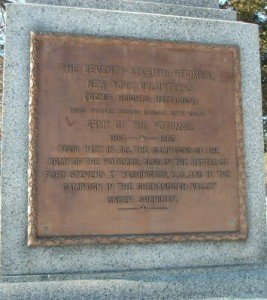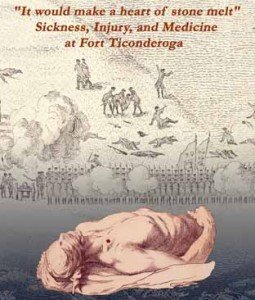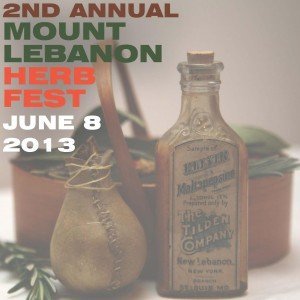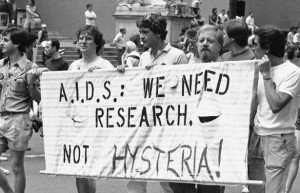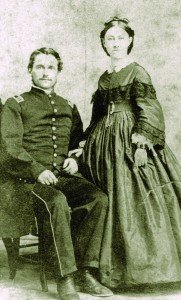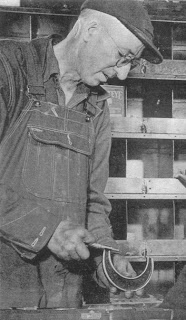 “Card of Thanks” entries were routine fare in newspapers of years past. They were commonly used by families acknowledging those who provided aid and comfort during times of bereavement. The “Cards” shared a standard format—citing doctors, nurses, and friends, followed by the names of the immediate-family members who were doing the thanking—but some stood out as unusual. The death of Crown Point’s Enos Dudley in 1950 is a case in point.Shortly after he passed, a Card of Thanks noted “the death of our beloved father, Enos J. Dudley” and featured the names of seven family members. Below it was a second Card of Thanks referring to Enos as “our beloved husband and father.” It ended with the names of six other family members.
“Card of Thanks” entries were routine fare in newspapers of years past. They were commonly used by families acknowledging those who provided aid and comfort during times of bereavement. The “Cards” shared a standard format—citing doctors, nurses, and friends, followed by the names of the immediate-family members who were doing the thanking—but some stood out as unusual. The death of Crown Point’s Enos Dudley in 1950 is a case in point.Shortly after he passed, a Card of Thanks noted “the death of our beloved father, Enos J. Dudley” and featured the names of seven family members. Below it was a second Card of Thanks referring to Enos as “our beloved husband and father.” It ended with the names of six other family members.
Intriguing, for sure. My suspicion was that there had to be a story there somewhere, so I began digging. As it turns out, Enos led a pretty normal life, spent almost entirely within a few miles of his birthplace. A few details about his family, however, proved to be anything but ordinary.He was born in 1869 and married Frances Kinney of Ticonderoga in 1888. Within a year they began raising a family. Sons Roy, Jerry, and John came in quick succession, followed by twins Ella and Della. By 1902, Walter, Greta, and Keith had brought the count up to eight children.At that same time, newspaper mention was made of the ninth daughter (unusual in itself) born to the Evangelist Cassina family of Ticonderoga, a fact that will tie in to Enos’ story later.In the early 1900s, typhoid fever was the scourge of many North Country communities. Deaths were common, and in 1909, the family of Enos Dudley was hard-hit. His wife, Frances, after frequent illnesses, succumbed to the disease in late June.The Dudley children, beset by sickness, were tended to by local doctors. Various women in the community looked after the family’s everyday needs as Enos struggled with the loss of his wife. In September, tragedy struck again when 20-year-old Roy, the oldest child, died.A few months later, six of the Dudley children were stricken with scarlet fever, but all survived and were on their way to recovery by spring, thanks once again to community support.In late 1912, Enos, 43, was engaged to marry 21-year-old Christina Cassina (second daughter of the aforementioned all-girl Ticonderoga family). They were joined on November 28 in Montreal.Nine months later, both of Enos’ families expanded. On August 7, he welcomed a grandson (his son Jerry was the father), and on August 10, Enos himself became a father again when Florence was born. There were two numerical twists associated with the births: Enos’s new wife (Christina) was one year younger than his son (Jerry), and Enos’ new daughter was three days younger than his new grandson!Unusual, certainly, but perhaps not qualified for the upper stratosphere of rarities. Still, Enos and Christina weren’t finished just yet. In 1915, when he was 46 and she was 24, they had a son, Roy. (This was Enos’ second Roy. His first Roy had died in 1909 from typhoid fever.) A series of health issues—back pain, a serious logging injury, and disabling bouts of sciatic rheumatism (sciatica)—plagued Enos as he aged, but in 1924, when he was 55 (life expectancy for a man then was 58), Christina gave birth to daughter Frances (named after Enos’ first wife).There was certainly no lack of drama or trauma in the life of Enos Dudley. Six months after Frances was born, Enos was buried beneath a load of wood that tipped over. He was hospitalized in critical condition with kidney damage and two broken ribs, but eventually recovered.In 1927, while working on road construction, he suffered serious injuries that almost resulted in the loss of an eye. Again, Enos survived, damaged but intact.In 1929, he nearly lost 14-year-old Roy in a winter sledding accident on Sugar Hill at Crown Point. On a roadway seldom used by automobiles, Roy was seated behind a 12-year-old friend when their speeding sled collided with a passing car. The younger boy was killed instantly, but his body cushioned the impact for Roy, who escaped with only minor injuries.Enos also suffered recurring bouts of severe rheumatism that required hospitalization. After one such incident, he was released from the hospital in spring 1930.Maybe it was the remarkable curative powers of the folks at the Moses-Ludington Hospital in Ticonderoga that kept him going. Whatever it was, apparently Enos felt realbetter real soon. In January 1931, nine months after his release, wife Christina gave birth to a daughter, Bernice. Already a grandfather many times over, the proud new dad was now 62 years old.Over the years, Enos worked many jobs to support his families, including farming, logging, operating an apartment building, driving a school bus, and working construction. In 1931 he ran one of the 20 gas stations (another very unusual number) that existed in Crown Point, and took a second job as night watchman at the Crown Point State Historic Site.Soon he returned to farming in the daytime while still maintaining the watchman job at night. Meanwhile, the family continued to grow, and within a few years, Enos was twice made a great-grandfather. Clearly his golden years would be filled with children of all ages.Perhaps that’s a bit of an understatement. On June 23, 1936, grandson William Enos Meldon was born to Enos’ daughter, Florence. And 20 days later, on July 13—if you haven’t already guessed—Enos and Christina welcomed their sixth child, Hugh.As crazy as it seems, this new son was younger than all of Enos’ grandchildren—and younger than his two great-grandchildren! Now THAT might qualify for any list of rare occurrences.Hugh was his 14th offspring. One child of Enos and Christina’s six children had not survived, so when Hugh was born, seven of eight children from Enos’ first marriage and five of six from his second marriage were all alive.In an interview, Enos said he worked two jobs and slept only four to five hours a day (and that any more sleep than that was a waste of time). Through hard times and near-fatal accidents, he had endured. No one would be questioning Enos Dudley’s stamina for those reasons, and perhaps one other: his youngest (Hugh) and oldest (the first Roy) children were born over 47 years apart … and long before the development of little blue pills.Another interesting coincidence: at that point, Enos’ wife Christina was 45, and he had been married for 45 years—21 to Frances and 24 to Christina.In 1939, Enos was hospitalized for heart problems and high blood pressure, but as tough as he was, two more years passed before he finally retired from the watchman job at age 72.Enos was finished having children of his own, but the family continued to grow, and the ups and downs of life continued. Daughter Frances was valedictorian of her class- son Roy served two years in Europe during World War Two- and wife Christina fell and broke her shoulder in 1948.Enos required more hospital stays and eventually moved to the Wells Nursing Home in Ticonderoga. In 1950, his grandson, Kenneth, 39, died following surgery. Three months later, Enos, 82, passed away, prompting two Cards of Thanks from two very appreciative families.Photo L to R: Daughter Florence Meldon, grandson William Meldon, son Hugh Dudley, and Enos Dudley—great-grandfat
her, proud new grandfather, and proud new father (1936).Lawrence Gooley has authored eleven books and dozens of articles on the North Country’s past. He and his partner, Jill McKee, founded Bloated Toe Enterprises in 2004. Expanding their services in 2008, they have produced 23 titles to date, and are now offering web design. For information on book publishing, visit Bloated Toe Publishing.
 In days of yore (pre-Internet times), I once subscribed to more than a dozen different magazines. Further back, in the 1960s and 1970s, there seemed to be a magazine for just about any subject that anyone was ever interested in. I was reminded of this last year when a saw a cover titled TWINS. The subject matter was everything related to twins: having them, being one, doctoring them, parenting them, and so on.
In days of yore (pre-Internet times), I once subscribed to more than a dozen different magazines. Further back, in the 1960s and 1970s, there seemed to be a magazine for just about any subject that anyone was ever interested in. I was reminded of this last year when a saw a cover titled TWINS. The subject matter was everything related to twins: having them, being one, doctoring them, parenting them, and so on.